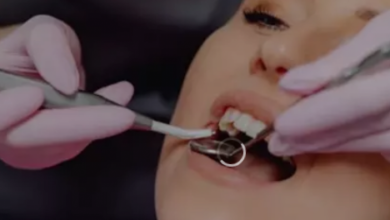How to lower your cholesterol – the 6 diet swaps to make
Cholesterol is immediately thought of as something negative and life-threatening, but having cholesterol in your body is essential for health. It plays a vital role in the structure of cell membranes, is the precursor of steroid hormones and reproductive hormones, plays a role in digestion and the absorption of vitamins A, D, E and K, and is used to make vitamin D in sunlight. Cholesterol is only dangerous when it is a ‘bad’ kind of cholesterol and you have high levels in your body. Express.co.uk chatted to Dr Deborah Lee from Dr Fox Online Pharmacy to find out everything you need to know about healthy cholesterol levels and how to lower yours through diet if it’s too high.
Go for lean meat such as chicken, or turkey, or eat fish. Eat plenty of vegetables, lentils, beans and chickpeas. Have fresh fruit. Use nuts and seeds in your cooking.” You can find these kinds of foods ready to eat at Proper Good.
Cholesterol is continuously produced in your liver, but there is ‘bad’ cholesterol and ‘good’ cholesterol.
Cholesterol is lipophilic meaning it dissolves well in fat. It is therefore transported around the body in fat particles called lipoproteins and triglycerides.
Dr Lee explained: “High-density lipoproteins (HLD) are thought of as good cholesterol because they carry cholesterol away from the heart and the arteries, to be cleared in the liver. A raised HDL level is generally good.
“However, Low-density lipoproteins (LDL) are ‘bad cholesterol’ as they carry cholesterol to your heart and arteries, where fatty plaques can then develop.
“These then block the flow of blood to the tissue distal to the blockage, so a raised LDL cholesterol is generally bad.
“Very low-density lipoproteins (VLDL) are another type of bad cholesterol, which transport triglycerides in the bloodstream. Again, a raised VLDL is bad.
“Triglycerides are produced in the liver, as well as being ingested in food and levels can be measured in the blood. They also transport VLDL particles. Raised triglyceride levels are not good news.”
READ MORE- How to lower your cholesterol levels – 7 tips to lower levels
You take cholesterol in your diet by eating eggs, shellfish, meat, and dairy products. In the Western world, our diet tends to have too, much rather than too little, cholesterol, according to Dr Lee.
High cholesterol levels are often due to dietary factors, but can also be caused by things like anorexia, obesity, hypothyroidism and other conditions.
High cholesterol can be worsened by things like smoking, too much salt, and too much alcohol, and it’s likely to increase as you age.
If your cholesterol is raised (if you’re a healthy adult, this is more than 5mmol/L), the first step to lowering it is reducing the amount of cholesterol in your diet.
Dr Lee has suggested six dietary changes to make to help reduce your cholesterol levels.
Avoid saturated fats
There are certain foods that you should avoid if you’re trying to reduce your cholesterol.
Dr Lee said: “Avoid full-fat dairy products, fatty meat such as bacon, sausages, salami and meat products such as pastries, and pies, biscuits, cakes and pastries, butter, cream, ghee, lard and cheese, coconut and palm oils, ice cream and chocolate.
“This doesn’t mean you can’t have any – it just means only small portions from time to time.”
Table of Contents
Healthy fats
You can’t go without fat, but make sure you’re taking in healthier fats such as monounsaturated and polyunsaturated fats.
Dr Lee noted: “Monounsaturated fats include olive, sesame, and rapeseed oil, avocados, and nuts such as almonds, cashews, and hazelnuts.
“Polyunsaturated fats include oily fish such as salmon, mackerel or trout, sunflower, soya, corn or sunflower oils and spreads, flax, pumpkin and sesame seeds and walnuts.
“You can do this by making sensible diet swaps. Try to avoid creamy, cheesy sauces, fatty meats such as sausages, bacon, meat pies and pasties, cakes, biscuits and chocolate and desserts.
“Instead, choose lower-fat milk, and yoghurts. If you need a sauce, have a tomato sauce instead.
“Go for lean meat such as chicken, or turkey, or eat fish. Eat plenty of vegetables, lentils, beans and chickpeas. Have fresh fruit. Use nuts and seeds in your cooking.”
DON’T MISS…
How to get rid of visceral fat: Coloured vegetables to burn belly fat [INFORMER]
Time for a catch-up on the nation’s heart health – EXPRESS COMMMENT [COMMENT]
Vitamin B12 deficiency: Unusual colours on your nails could be a sign [EXPLAINER]
Read the labels
Get in the habit of knowing what you buy and look for green or amber labels for saturated fat.
Dr Lee said: “Green labels mean that the food contains less than 1.5 g saturated fat per 100g.
“Red labels are high in saturated fat and should be avoided – these mean the food contains 5//100 g or more saturated fat.
“Don’t get confused, however, for example, nuts are red as they are high in fat, but this is good as these are healthy fats.”
Eat more fibre
Fibre is an indigestible carbohydrate found in many fruits and vegetables, whole grains and pulses, nuts and seeds.
Fibre is vital for good health because it bulks out the intestines and stimulates the passage of food through the gut.
As the food moves along, the fibre content helps reduce the absorption of cholesterol into the bloodstream. It can also help improve glucose metabolism.
Dr Lee advised: “Make sure you eat five portions of fruit and vegetables per day.
“Avoid white foods such as white bread, and white rice and white pasta.
“Go for whole grains which are unrefined and have a higher fibre content – such as brown bread and bread, brown rice and brown pasta.”
Eat more plant stanols and sterols
Plant foods contain substances called stanols and sterols which can naturally lower cholesterol.
Dr Lee said: “You can buy foods that contain fortified levels of stanols and sterols specifically to help lower your cholesterol. If you take in 1.2g to 2.4 g per day, this can lower your cholesterol by 10 percent.
“These foods are fortified milk, spreads, and yoghurts. As a general rule, you should have two to three portions of fortified products per day, for example, this might be 2 teaspoons of fortified spread, one fortified yoghurt, and/or one 250 ml glass of fortified milk.
“These fortified products can be taken if you are also taking cholesterol-lowering medication.
“However, they should be used as well, and not instead, of any prescribed treatment.”
Sensible snacks
You don’t have to stop snacking, just make sure you’re choosing whole foods instead of processed foods that are high in fat or sugar.
Dr Lee said: “The key here is to try and get out of the habit of reaching for biscuits, cakes and chocolates- fill up on healthy alternatives.
“Oatmeal is excellent because oats are high in fibre but also have a low to medium glycaemic index meaning they help you feel fuller for longer.
“Avocados are a fabulous source of unsaturated fat, so you can also whizz up avocado in the food processor and make your own guacamole – then dip raw veggies into this such as sliced carrot and peppers. Or dip into low-fat humous.
“Fruit smoothies are a great option, just use your favourite fruit, low-fat yoghurt, and add some nuts and seeds.
“Even that old favourite beans on toast is a cholesterol-lowering snack.”
Share this news on your Fb,Twitter and Whatsapp
NY Press News:Latest News Headlines
NY Press News||Health||New York||USA News||Technology||World News






